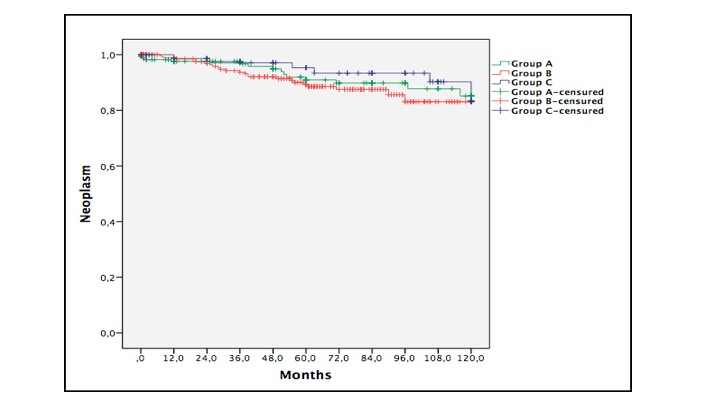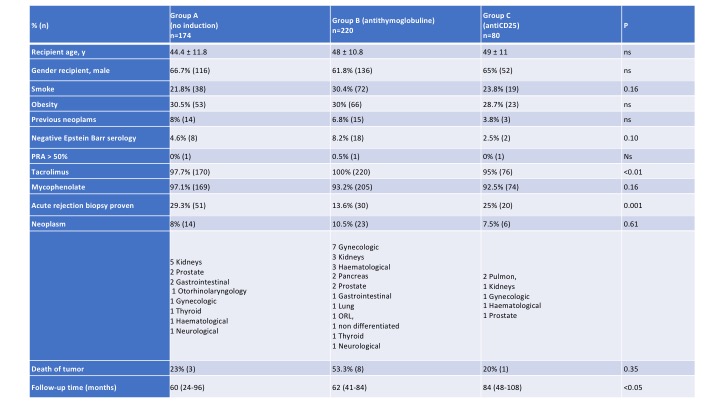Malignancy Complications after Kidney Transplantation with Different Immunosuppression Induction Protocols.
Maria Molina1, Jimena Cabrera2, Esther Gonzalez1, Natalia Polanco1, Ana Hernandez1, Amado Andres1.
1Department of Nephrology, Hospital Universitario 12 de Octubre, Madrid, Spain; 2Department of Nephrology, Hospital Evangelico, Montevideo, Uruguay
Introduction: Immunosuppression therapy is essential to avoid rejection after kidney transplantation. The chronic use of this drugs increases the risk of malignancy compared to general population. Oncology complications are a main cause of recipient death. The increase the knowledge about the prevalence and risk factors could decrease the incidence and implement screening protocols for an early diagnosis.
Materials and Methods:We compared the incident of non-cutaneous cancers after 10 years of follow-up in three cohorts of kidney transplantations: Group A non-induction antibodies therapy Group B received thymoglobulin and Group C received antiCD25. All patients received steroids, calcineurina inhibitors (tacrolimus vs cyclosporine) and mycophenolate vs azathioprine. We performed a Kaplan Meier survival curves freedom of neoplasm between the three different groups. We analysed risk factors associated with the development of neoplasm.
Results: Of the 474 kidney transplantations, 9% (43) had a non-cutaneous neoplasm after 10 years of follow up. The neoplasms were: 9 kidney-urinary tract malignancies, 9 gynecologic, 5 prostate, 5 haematological, 3 gastrointestinal, 3 lung, 2 otorhinolaryngology, 2 thyroids, 2 neurological, 2 pancreas and 1 non differentiated. We shown in Table 1 the characteristics of the patients in the Group A, B and C. The Graphic 1 shown the survival free-neoplasm in the three groups, but there isn’t any difference between the groups (p>0.05). The multivariate analysis shown that recipient age > 55 years (HR: 2.4 [CI 1.3-4.5, p=0.006]), previous hemodialysis as renal replacement therapy (HR: 1.9 [CI 0.96-3.7, p=0.06]) and previous neoplasm (HR: 4.1 [CI 1.8-9.3, p=0.001]) were the main factors to develop a neoplasm after kidney transplantation. 33 patients died after 10 years of the follow up, the main causes of deaths were cardiovascular (48.5%) and neoplasm (36.4%) causes.


Conclusions: The main non-cutaneous neoplasm were related with urinary tract, gynecologic and haematological. The age older than 55 years old, previous hemodialysis renal replacement therapy and previous neoplasm were the factors related with a develop of a neoplasm after kidney transplantation. We didn’t find any relationship with immunosuppression induction therapy. Oncology cause was the second cause of death in our cohort. The introduction of a neoplasm screening programme after kidney transplantation could decrease the incidence of tumor and increase recipient survival.
